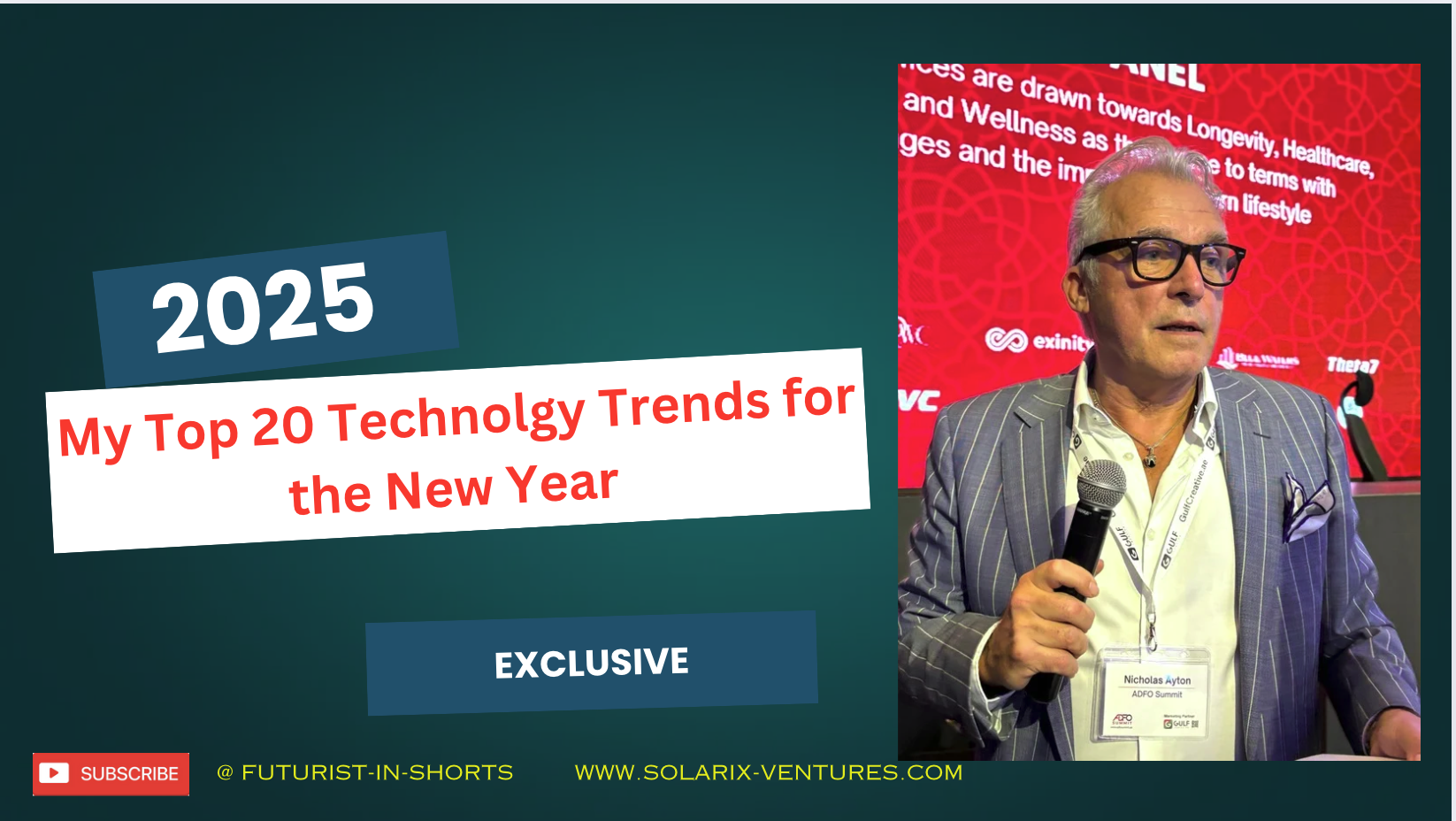Exclusive Content:
Here are my Top 20 technology trends and breakthroughs that will make strong moves in 2025. Opening up new frontiers, and opportunities for competitive advantage.
1. Biological Computing
What it is: Biological computing uses biological materials and systems—such as DNA, RNA, or cells—as computational elements instead of traditional silicon-based processors. These bio-processors can perform computations in parallel, leveraging biochemical processes.
Why it’s powerful: Unlike digital processors that rely on electricity and generate heat, biological computing operates with near-zero energy consumption and unparalleled efficiency. These systems are capable of mimicking nature’s complexity, solving problems like protein folding, drug discovery, and large-scale simulations faster and more efficiently than traditional supercomputers.
Why it will trend: As we approach the physical limits of Moore’s Law, biological computing offers a pathway to energy-efficient, scalable solutions for computationally intensive tasks. Its implications for biotech, healthcare, and climate modelling will make it a focal point in R&D.
2. Post-Quantum Infrastructure
What it is: This refers to the systems and protocols designed to secure and operate in a quantum computing world. These include quantum-safe encryption algorithms, post-quantum cryptography, and secure data transmission systems to replace vulnerable cryptographic standards like Elliptic Curve Cryptography and SHA 256/512.
Why it’s powerful: Quantum computers will break much of today’s encryption, posing a massive risk to data security across industries. Building infrastructure capable of withstanding these threats is critical to protecting global financial systems, communications, and government operations.
Why it will trend: With quantum computing moving closer to practical deployment, governments, corporations, and tech giants are racing to adopt post-quantum solutions. The stakes are existential, and adoption will accelerate as awareness grows.
3. Web3
What it is: A decentralised web powered by blockchain and peer-to-peer networks that returns sovereignty over data, identity, and digital experiences to users. Web3 emphasises privacy, transparency, and community governance.
Why it’s powerful: By eliminating intermediaries, Web3 transforms the internet into a user-controlled ecosystem. Customers will control their data and digital identities, participate in governance, and earn rewards for engagement. It enables new business models, such as decentralized finance (DeFi), NFTs, and DAOs.
Why it will trend: As trust in centralised institutions erodes and privacy concerns mount, Web3 offers a compelling alternative. The convergence of blockchain, AI, and edge computing will push Web3 applications mainstream.
4. Stem Cell Therapeutics
What it is: Advanced stem cell therapies focus on regenerating damaged tissues, organs, and cells to treat chronic diseases and extend human lifespan at cellular level. Can slow and even reverse the effects of aging.
Why it’s powerful: Stem cell therapies have already shown potential in treating previously incurable diseases like Parkinson’s, diabetes, and spinal injuries. They also open doors to anti-aging treatments, organ regeneration, and personalised medicine.
Why it will trend: As bio-manufacturing and regulatory hurdles ease, the affordability and availability of stem cell therapies will increase. Aging populations and the global focus on longevity science will further drive investment and adoption.
5. Implants
What it is: Bio-electronic and bio-mechanical implants that enhance or restore physical and cognitive functions. Examples include neural implants for brain-computer interfaces, cochlear implants for hearing, and microchips for medical monitoring. New implants live in your gut, can be steered around your body to enhance real time monitoring and biomarker data collections.
Why it’s powerful: Implants bridge the gap between biology and technology, enabling unprecedented enhancements to human health, cognition, and connectivity. They are pivotal in restoring lost functions and unlocking transhuman potential.
Why it will trend: Advances in miniaturisation, biocompatibility, and wireless connectivity make implants more effective and accessible. Aging populations and growing interest in human augmentation will fuel demand.
6. Cognitive AI
What it is: AI systems designed to understand, simulate, and enhance human cognitive processes, including emotional intelligence, decision-making, and mental health support. Continued isolation, damaging social media manipulations a causation of mental illness – cognitive AI systems detect and step in to offer support.
Why it’s powerful: Cognitive AI goes beyond task-based automation, offering personalised interventions for mental health, productivity, and learning. It can detect early signs of anxiety or depression and provide proactive solutions.
Why it will trend: The mental health crisis, coupled with workplace demands for optimised performance, will drive investment in cognitive AI. As AI becomes more empathetic, its adoption will surge in healthcare, education, and corporate wellness.
7. Multiomics
What it is: The integration of multiple omics fields—such as genomics, proteomics, meta-bolomics, and epigenomics—to provide a holistic view of biological systems. The potential for universal repairs of the human body is closer than ever.
Why it’s powerful: Multiomics enables precise insights into disease mechanisms, drug responses, and personalised treatments by analysing the interplay of genes, proteins, and metabolites.
Why it will trend: With advancements in data analytics and reduced sequencing costs, multiomics will revolutionise drug development, early disease detection, and personalised healthcare.
8. Robotic Surgery
What it is: Advanced surgical systems powered by robotics and AI that enhance precision, reduce invasiveness, and improve patient outcomes.
Why it’s powerful: Robotic systems can perform complex procedures with greater accuracy, minimal human error, and faster recovery times. They expand access to high-quality surgery in remote or underserved regions.
Why it will trend: As AI integrates into surgical systems, capabilities like real-time imaging and predictive modelling will make robotic surgery the gold standard for many procedures.
9. Rise of Transhumanism
What it is: The integration of technology with human biology to enhance physical, cognitive, and emotional capabilities has arrived as humans merge with technology as never before.
Why it’s powerful: Transhumanism extends human potential, enabling breakthroughs in longevity, intelligence, and physical endurance. It also raises profound ethical questions about identity and equality.
Why it will trend: Advances in implants, AI, and regenerative medicine are making transhumanism less of a philosophy and more of a practical reality.
10. Biomaterials
What it is: Materials engineered from biological sources for applications in medicine, manufacturing, and sustainability. Examples include biodegradable plastics and bioengineered tissues, intelligent materials that are natural and deliver sustainable solutions – bio-graphene solar capture, super light and strong bio-graphene concrete, with useful thermal properties.
Why it’s powerful: Biomaterials offer sustainable solutions to environmental challenges and enable innovations in regenerative medicine, prosthetics, and wearable devices.
Why it will trend: As demand for eco-friendly alternatives and medical advancements grows, biomaterials will be a cornerstone of future industries.
11. Polygenics
What it is: The study of how multiple genes interact to influence traits and diseases, enabling new levels of genetic insight and therapeutic development. New AI platform for spotting human defects and potential at embryonic stages.
Why it’s powerful: Polygenics moves beyond single-gene analyses, providing a comprehensive understanding of complex diseases like diabetes and heart disease. Linked to a Longevity platform – life can be predicted and managed.
Why it will trend: Advances in machine learning and genetic databases will accelerate the practical application of polygenics in healthcare and personalised medicine, to extend biomarker analysis.
12. Zeroism (AI-Personalized Healthcare)
What it is: A healthcare paradigm where AI delivers hyper-personalised interventions based on real-time biometrics, genetics, and environmental factors. Capturing the thousands of data points from bio-markers in real time will deliver the nudge humans needs to live better and longer.
Why it’s powerful: By tailoring treatments and lifestyle recommendations, Zeroism can optimise health outcomes and prevent chronic conditions, what works and doesn’t, how different people react to the same environments, lifestyles, minerals and vitamins.
Why it will trend: With wearable devices and health apps becoming ubiquitous, AI-driven healthcare will reshape how we manage and maintain health.
13. Non-Invasive Brain Interfaces
What it is: Brain-computer interfaces that enable communication and control without invasive implants, using technologies like EEG and magnetoencephalography. Cognitive support systems to aid human development and progress.
Why it’s powerful: These interfaces unlock capabilities like controlling devices through thought, aiding disabled individuals, and enhancing cognitive performance.
Why it will trend: Advances in signal processing and machine learning are making these interfaces more effective and accessible.
14. Physical Twinning
What it is: The physical counterpart to digital twinning, where precise replicas of biological or mechanical systems are created for testing and optimisation. A game changer in testing new drugs and treatments prior to delivery to the live host.
Why it’s powerful: Physical twinning bridges the gap between simulations and real-world applications, enabling rapid prototyping and validation.
Why it will trend: As industries demand faster innovation cycles, physical twinning will become a key tool for R&D. And will eventually lead to replacement organs and tissues – from the host by the host.
15. Cures for Dementia & Alzheimer’s
What it is: Breakthrough therapies targeting the underlying mechanisms of neurodegenerative diseases, such as amyloid plaques and tau proteins. The clear pathways but also re-set brain cells using vibrations and frequencies to trigger cognitive re-routing and recovery.
Why it’s powerful: Effective cures will transform aging societies, reducing healthcare costs and improving quality of life for millions.
Why it will trend: Advances in gene therapy, multiomics, and drug discovery make this goal achievable within the next decade.Specifically driven by the field of cymatics.
16. Agenic AI
What it is: Agenic AI represents a departure from goal-driven artificial intelligence, creating systems capable of adapting dynamically without being tied to predefined objectives. These systems continuously learn from their environment, adjusting behaviour and decision-making in real-time based on contextual changes.
Why it’s powerful: Traditional AI is bound by narrowly defined tasks (e.g., optimising a route or predicting trends). Agenic AI, however, mimics human adaptability, capable of tackling complex, unstructured, or rapidly changing problems that lack clear objectives. Cities and buildings of the future will be conscious and looks after its occupants.
Why it will trend: The ability to handle uncertainty and ambiguity makes agenic AI a game-changer for industries like defense, logistics, and autonomous systems. As the demand for more versatile and context-aware AI grows, agenic systems will be key to achieving human-like cognition in machines.
17. Ambient Invisible Intelligence
What it is: This refers to AI and IoT systems that blend seamlessly into everyday environments, providing intelligent functionality without requiring active user interaction. For example, a smart home might adjust lighting, temperature, and security settings autonomously based on user habits and preferences.
Why it’s powerful: Unlike current “smart” technologies, which often demand user input or control via apps, ambient intelligence works in the background, making decisions proactively based on sensor data, behavioural analysis, and environmental cues. This creates a more intuitive and effortless experience, effectively turning any space into a “smart space.”
Why it will trend: The rise of edge computing, energy-efficient sensors, and advances in AI make ambient intelligence feasible on a large scale. In homes, offices, healthcare settings, and cities, these systems will provide personalised, invisible support—enhancing comfort, security, and productivity while saving energy and reducing device clutter.
18. Polyfunctional Robots
What it is: These are robots designed with modularity and flexibility in mind, enabling them to perform a wide range of tasks rather than being restricted to a single purpose. For instance, a factory robot might shift from assembling products to inspecting quality, or a healthcare robot might assist with surgery and then transition to patient care.
Why it’s powerful: The traditional model of single-purpose robots is limited in adaptability and cost-efficiency. Polyfunctional robots leverage advancements in AI, sensors, and modular hardware to deliver multitasking capabilities, which improves their utility and ROI across industries. They also adapt to changing needs without requiring expensive retooling or new devices.
Why it will trend: Labor shortages, particularly in aging populations, will drive adoption in healthcare, logistics, and manufacturing. Advances in robotics AI will enable robots to “learn on the job,” making them indispensable in dynamic environments where multitasking is key.
19. Disinformation Security
What it is: This involves the development of technologies to detect, counter, and prevent the spread of false or misleading information online. These systems include deepfake detection algorithms, AI-based fact-checking, and blockchain solutions for content verification – automated systems that flag false narratives and motives.
Why it’s powerful: The proliferation of generative AI tools capable of creating hyper-realistic fake content poses significant threats to trust in media, governance, and society. Disinformation campaigns can manipulate public opinion, destabilise economies, and even influence elections. Technologies that can identify and neutralise these threats in real time are crucial to maintaining societal stability.
Why it will trend: With regulatory bodies and corporations under growing pressure to combat disinformation, investment in AI-based detection and verification tools will surge. The convergence of AI, natural language processing, and blockchain will power next-generation tools to address these challenges, reshaping how we verify information online.
20. Synthetic Biology Platforms
What it is: Synthetic biology uses engineering principles to design and construct new biological parts, systems, and organisms. These platforms can create everything from engineered bacteria that clean up oil spills to custom enzymes for drug manufacturing.
Why it’s powerful: By rewriting the building blocks of life, synthetic biology can solve some of humanity’s most pressing challenges. For instance, it could enable sustainable production of biofuels, biodegradable materials, and lab-grown meats, drastically reducing environmental impact. In medicine, it can accelerate the development of personalised treatments, including synthetic immune cells to fight cancer.
Why it will trend: Synthetic biology platforms are reaching a tipping point due to advancements in CRISPR, gene synthesis, and computational biology. As these tools become more accessible and affordable, industries ranging from agriculture to pharmaceuticals will rapidly adopt them, unlocking unprecedented innovation.
Final Thoughts:
These technologies complement the broader themes of intelligence, personalisation, sustainability, and human augmentation that dominate the list. We live in an ‘all at once’ moment where each of these deliver profound impact on humanity, society and our lives, but in combination will fundamentally change the way we live, work, interact and prosper.




